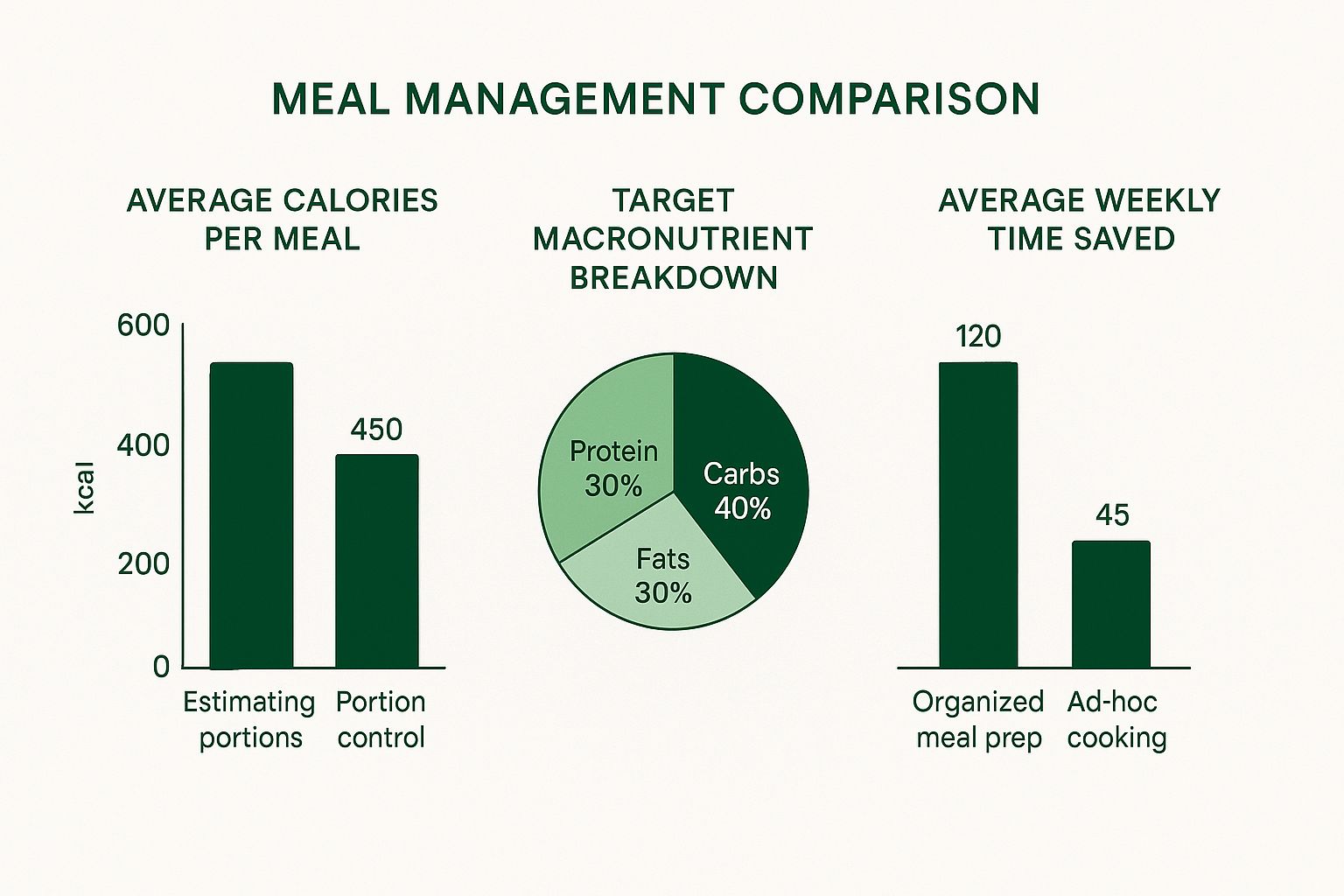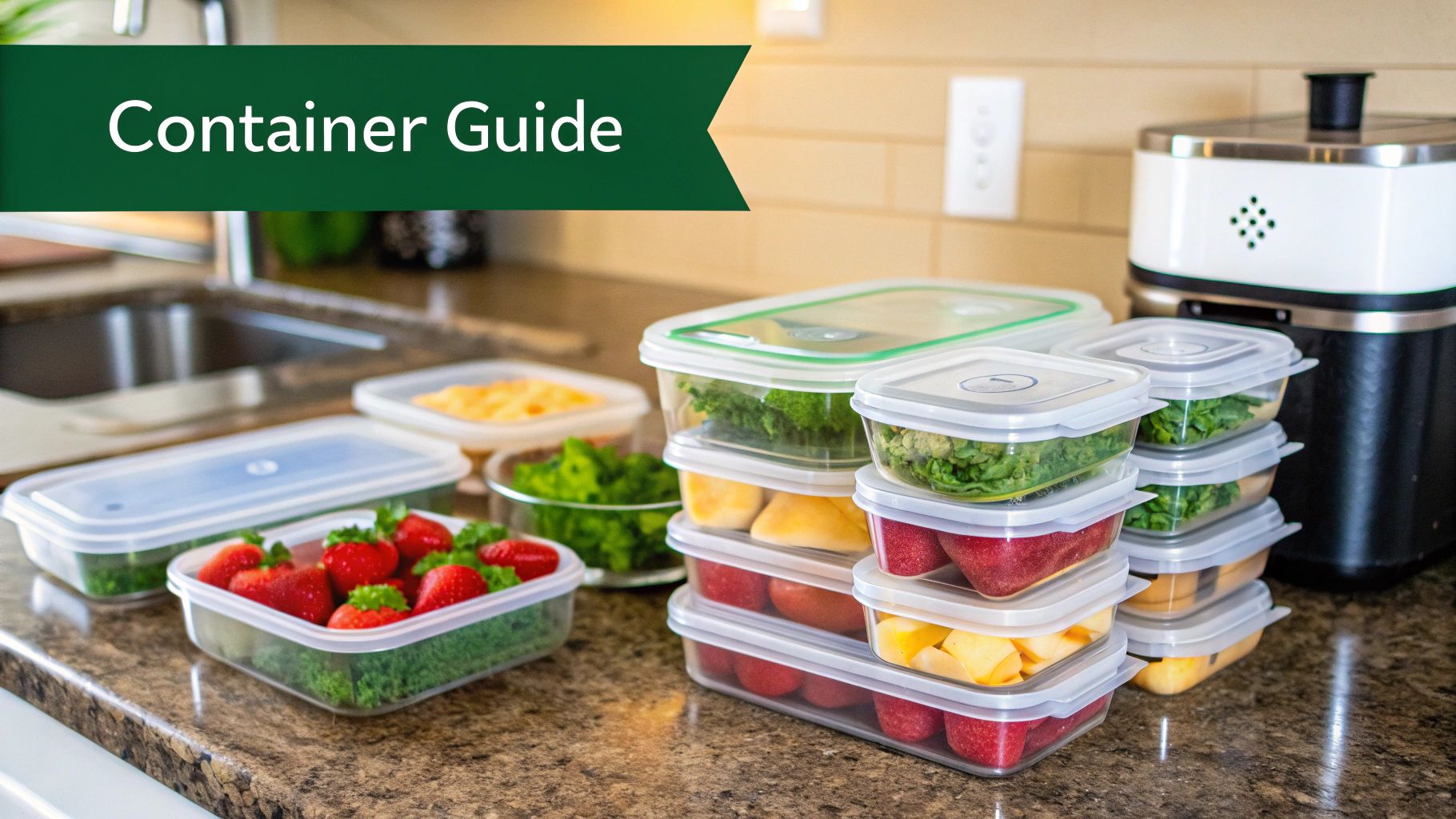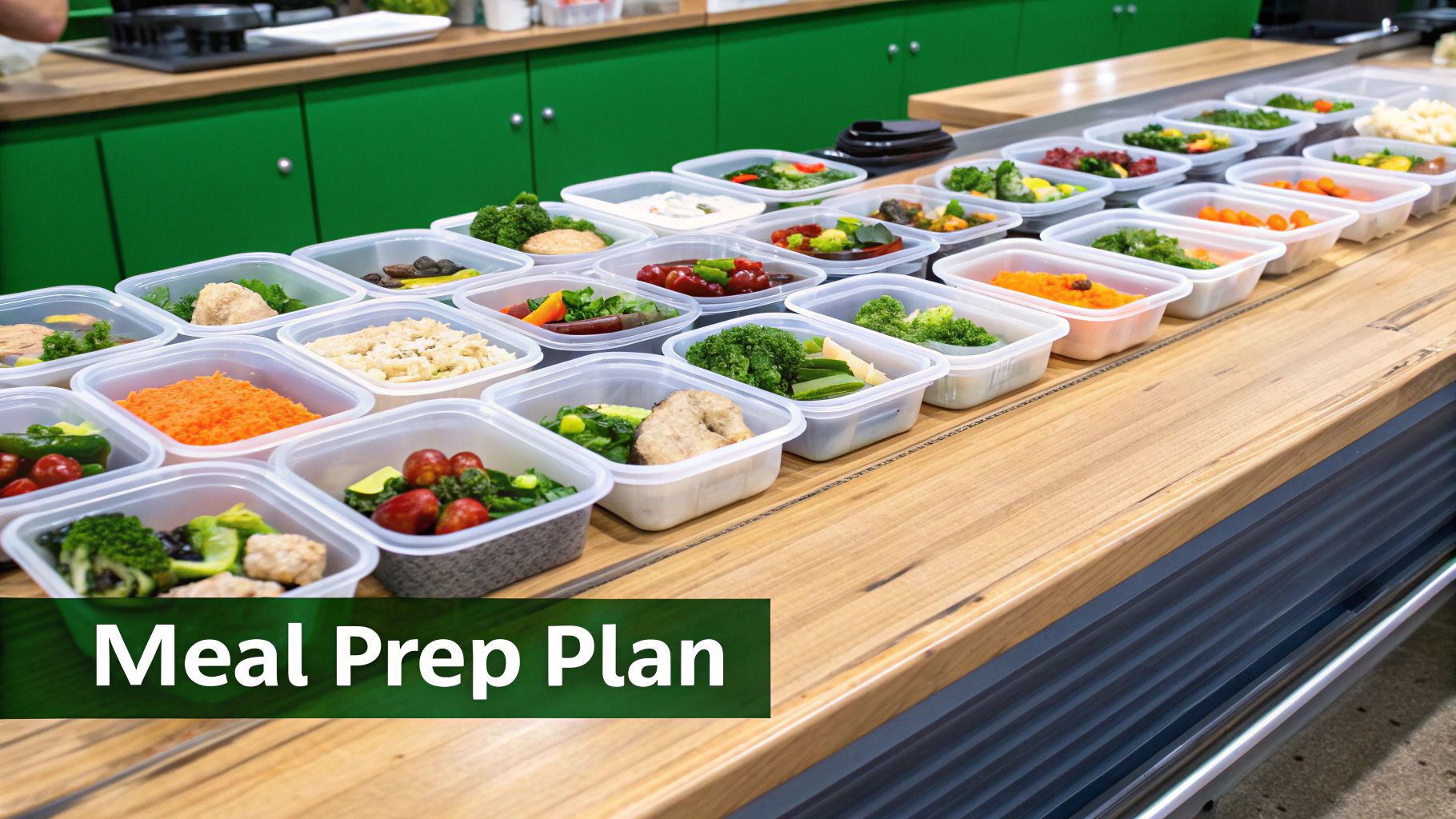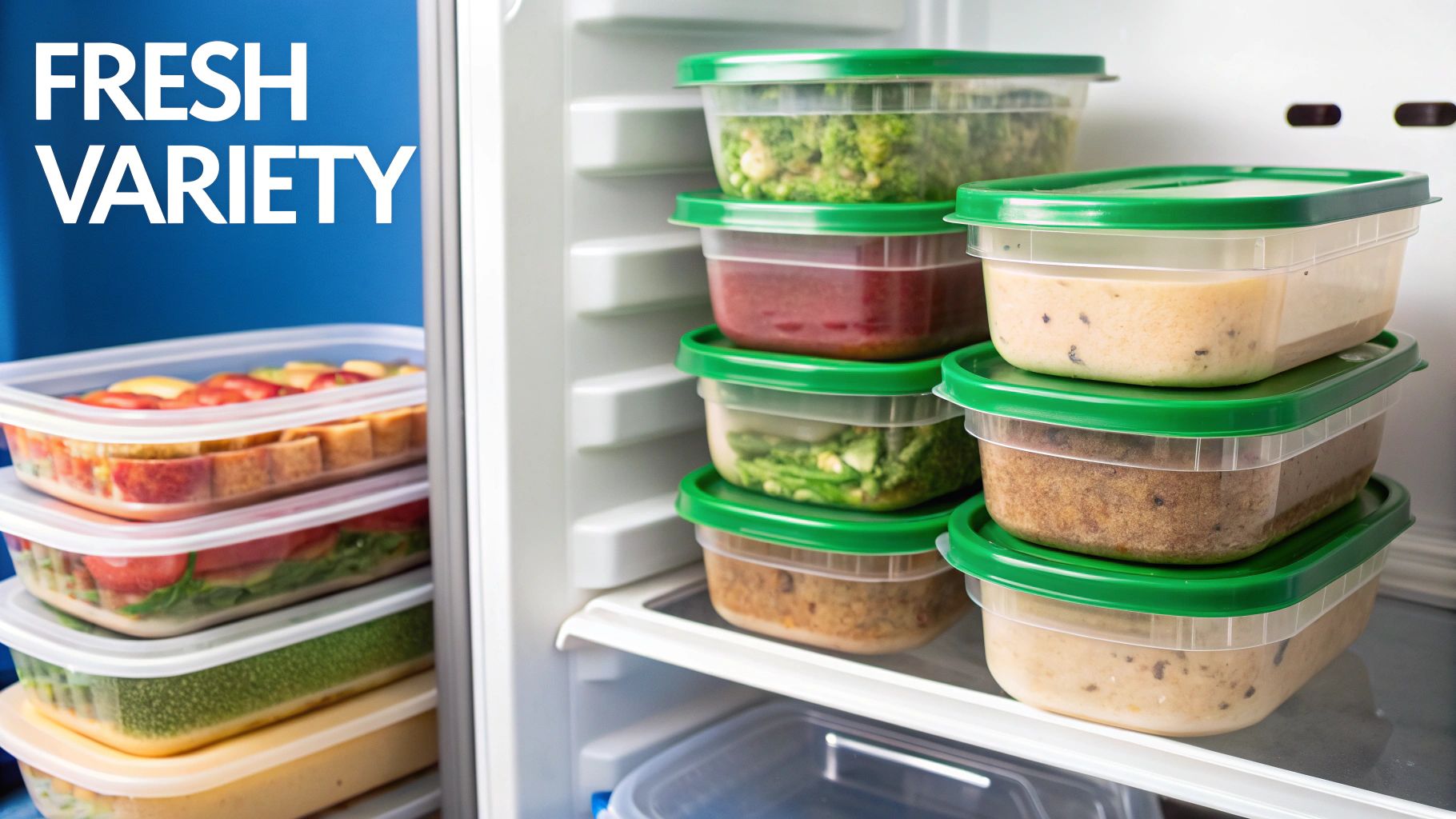Your Guide to Portion Control Meal Prep Containers
Master your meals with the right portion control meal prep containers. Learn how to choose, use, and organize your way to a healthier and simpler lifestyle.
Ready to Simplify Your Meal Planning?
Get personalized meal plans and grocery lists automatically matched to your macro targets.

Your Guide to Portion Control Meal Prep Containers
Let’s be honest, these containers are so much more than just fancy Tupperware. Think of them as your personal nutrition coach, built right into a box. They’re a genius system designed to help you nail how much you eat, which is often a bigger battle than what you eat. With pre-measured sections, they kill the guesswork and give you a simple, visual roadmap to a balanced plate.
Your Secret Weapon for Hitting Nutrition Goals
We’ve all been there. You start the week with rock-solid intentions, picturing salads and perfectly grilled chicken. But by Wednesday? Life happens. You're exhausted, starving, and suddenly that greasy takeout menu looks like a Michelin-starred masterpiece. This is exactly where portion control containers change the game. They swap that chaotic, last-minute decision-making for a calm, intentional plan.
This isn't about some miserable, restrictive diet. It’s about taking back control. When you see your meals laid out—protein in its spot, a mountain of veggies over here, and a sensible serving of carbs—it just clicks. That visual clarity is the "aha!" moment so many people are missing. Mealtime stops being a source of stress and becomes a simple, satisfying part of your day.
The Power of Visual Cues
One of the sneakiest enemies of healthy eating is "portion distortion." Our idea of a normal serving size has become super-sized over the years, and it's tough to eyeball it correctly. These containers are your cheat sheet, instantly recalibrating your brain to what a proper portion actually looks like.
The best part? You stop having to weigh and measure every little thing. The containers do the heavy lifting, building good habits in the background. Before you know it, you start to just know what a healthy serving of quinoa or broccoli looks like, making smarter choices automatically, even when you're eating out.
This infographic really drives home the difference between guesstimating and planning.

As you can see, a little structure goes a long way. We're talking better calorie control, macronutrient balance, and a serious amount of time saved every single week.
More Than Just a Trend
If you feel like you’re seeing these containers everywhere, you’re not wrong. But it’s not just another fleeting wellness fad. It’s part of a bigger movement toward mindful eating and creating health habits that actually stick.
The numbers back it up. The global market for these reusable containers hit USD 2.8 billion in 2024 and is projected to skyrocket to USD 4.9 billion by 2033. This isn't just a niche product; it's a reflection of people everywhere wanting practical, simple tools to make a healthy lifestyle less of a chore. You can dig into more of the market research and its drivers on DataHorizzon Research.
Finding Your Perfect Container Sidekick
Let's be real—not all meal prep containers are created equal. Your mission is to find the perfect sidekick for your lifestyle, your budget, and what you actually plan to eat. Think of this as your personal shopping guide to avoiding those flimsy lids, mystery stains, and the inevitable kitchen cabinet avalanche.
The first big decision you'll make is the material. This choice affects everything from durability and how you can use the container to even how your food tastes. Let's break down the main contenders.
The Great Material Debate
Plastic (BPA-Free) containers are the undisputed champs of affordability and grab-and-go convenience. They're super lightweight, which is a huge plus for your work bag, and they usually come in big, budget-friendly packs with all sorts of compartment layouts. The golden rule? Make sure they are explicitly labeled BPA-free, microwave-safe, and dishwasher-safe. No compromises there.

Glass containers are the heavy-duty heroes of the meal prep world. They absolutely will not stain (goodbye, stubborn spaghetti sauce marks!), they don't hold onto odors from last week's salmon, and they won't warp in the dishwasher. Food just tastes better out of glass, and you can often take them straight from the fridge to the oven or microwave. The catch? They're heavier and, well, breakable.
Stainless steel brings a sleek, modern, and incredibly durable option to the table. It’s nearly as lightweight as plastic but has the stain- and odor-resistant powers of glass. The major deal-breaker for many, though, is that you cannot put stainless steel in the microwave. This makes it a fantastic choice for salads, sandwiches, fruit, and other cold meals, but not for your leftovers that need a good nuking.
This focus on better materials isn't just a fad. We're seeing a huge market shift where manufacturers are ditching cheap plastics for eco-friendly, biodegradable, and BPA-free options to meet our demands. Cool innovations like vacuum seals and moisture-wicking features are also becoming standard. You can dive deeper into the latest trends in meal prep container manufacturing to see just how much things are changing for the better.
Container Material Showdown: Glass vs. Plastic vs. Stainless Steel
Struggling to decide? This quick-glance comparison will help you figure out which material best fits your daily needs, budget, and meal prep style.
| Feature | Glass | Plastic (BPA-Free) | Stainless Steel |
| Durability | Prone to chipping/breaking | Can warp or crack | Extremely durable, dent-resistant |
| Stain/Odor Resistance | Excellent; non-porous | Prone to staining and odors | Excellent; non-porous |
| Weight | Heavy | Lightweight | Lightweight |
| Microwave Safe? | Yes | Yes (check label) | No |
| Oven Safe? | Yes (check lid) | No | Yes (check lid) |
| Price Point | Mid to High | Low | Mid to High |
| Best For | Leftovers, baking, home use | Commuting, kids' lunches, bulk prep | Salads, sandwiches, cold snacks |
Ultimately, there's no single "best" material—it's about what works for you. Many meal preppers (myself included) use a mix: glass for hearty dinners at home and lightweight plastic or steel for lunches on the go.
Non-Negotiable Features to Look For
Okay, once you've picked a material, a few key features separate a good container from a truly great one. Don't settle on these—they make a massive difference in your day-to-day routine.
- Truly Leak-Proof Seals: This is the big one. Seriously. Look for containers with thick silicone gaskets and locking tabs on all four sides. There is nothing—and I mean nothing—worse than discovering your lentil soup has staged a jailbreak inside your work bag.
- Microwave and Dishwasher Safety: Meal prep is all about convenience. A container that forces you to hand-wash or transfer food to another dish for heating is creating more work. That defeats the whole purpose! Always check for the little symbols on the bottom.
- Smart Compartment Design: Multi-compartment containers are pure genius for keeping foods from mingling. They stop your crunchy salad toppings from getting soggy and prevent your sauce from turning everything into a single, mushy mess. Think about what you'll be packing. A bento-style box with three or more sections is perfect for a variety of snacks, while a simple two-compartment container is great for a main and a side.
The ultimate goal is to find a set of portion control meal prep containers that feels like a natural extension of your kitchen. They should make your life easier, not add another chore to your to-do list. Investing in a quality set that ticks all these boxes will pay off every single time you grab a perfectly prepped, delicious meal.
Your Blueprint for a Flawless Meal Prep Day
Let's be honest, the Sunday meal prep scramble can feel like another full-time job. But it doesn't have to be a frantic, kitchen-destroying disaster. What if I told you it could be a smooth, satisfying, and maybe even fun ritual?
This is your new playbook. We're going to turn that weekly chore into a genuine act of self-care. Forget the stress and last-minute panic. We're building a system.

The real magic isn't in some complicated, gourmet meal plan that has you crying over a soufflé. It's all about keeping it simple and being strategic. It all starts with having a clear vision for your week.
Map Out Your Menu
Before you even think about touching a knife, grab a notepad or open your phone. The first step is always to sketch out your lunches and dinners for the next five days. And please, don't overcomplicate it!
Think in terms of a simple formula, not five-star restaurant menus. My go-to is Protein + Carb + Veggie. This framework makes mixing and matching a breeze and keeps grocery shopping focused.
Need some inspiration? Here’s what a typical five-day lunch plan looks like for me:
- Monday: Grilled chicken, roasted broccoli, and quinoa. Classic.
- Tuesday: Lemon-dill salmon with asparagus and brown rice.
- Wednesday: Lean ground turkey stir-fry with mixed bell peppers (I pack the sauce separately!).
- Thursday: A hearty chickpea and spinach curry over that same quinoa from Monday.
- Friday: Back to the grilled chicken, but this time with roasted sweet potatoes and green beans.
See the overlap? I'm not cooking ten different things. I’m cooking chicken once, quinoa once, and roasting a few trays of veggies. This "cook once, eat twice (or thrice!)" strategy is the absolute key to an efficient prep day.
Master the Art of Batch Cooking
Alright, menu's set. Now it’s time to become a batch-cooking champion. This is where you cook the core building blocks of your meals in bigger quantities to use all week long. Trust me, this is the single biggest time-saver in the entire meal prep game.
Your goal is to cook smarter, not harder. By prepping versatile ingredients in bulk, you create a "food bank" in your fridge that lets you assemble diverse meals in minutes. Think of it as your own personal healthy food buffet.
I focus my energy on these three categories:
- Grains: Get a big pot of quinoa, brown rice, or even something like farro simmering on the stove. These are your workhorse bases for bowls, salads, and sides.
- Proteins: I'll bake or grill a family-pack of chicken breasts seasoned simply with salt, pepper, and garlic powder. At the same time, I might brown a pound of lean ground turkey and hard-boil a dozen eggs. Maximum output, minimal effort.
- Vegetables: This is where your oven becomes your best friend. Toss broccoli florets, chopped bell peppers, asparagus spears, and sweet potato chunks with a little olive oil and roast them on big sheet pans until they're just right. Roasted veggies hold up beautifully in the fridge.
The Assembly Line System
Now for the fun part—putting it all together. Line up your portion control meal prep containers on the counter and get that assembly line humming. This method is ridiculously fast and guarantees every meal is balanced.
I always start by scooping the carb base into each container. Next comes the protein, and finally, I top it all off with those delicious roasted vegetables. A crucial tip: for anything with a sauce or dressing, use a small, separate container or the little compartment in your container. This is non-negotiable if you want to avoid a soggy, tragic lunch.
This system completely takes the guesswork out of portioning. You're not weighing or measuring; you're just filling the slots. Your portion control meal prep containers do all the heavy lifting for you, creating meals that look great and are perfectly balanced.
In less than two hours, you can have a fridge stocked with healthy, grab-and-go options, setting yourself up for a week of pure success.
Meal Prep Mastery and Pro-Level Hacks
Alright, so you've got your shiny new containers and you're cranking out meals like a well-oiled machine. Fantastic. But now it's time to graduate from the basics and learn the tricks that make meal prep a true lifestyle, not just a Sunday chore.
Let's start with a big one: the difference between ingredient prepping and full meal prepping. Think of full meal prepping as the classic approach—you cook five identical servings of chicken, broccoli, and rice. It's fast and effective, but let's be honest, by Thursday, your taste buds might be staging a rebellion.
Ingredient prepping is the secret weapon against food boredom. Instead of making complete meals, you create a "buffet" in your fridge. You'll cook up a big batch of chicken, roast a pan of veggies, make some quinoa, and keep it all separate. This way, you can mix and match all week, creating different bowls, salads, or wraps on the fly.
The Color-Coding Trick
This next hack is so simple it’s brilliant. If your container set came with different colored lids, like the ones from the popular 21 Day Fix system, don't just see them as decoration. They’re a built-in organization system waiting to happen.
- Green Lids for Monday: Start the week off on the right foot.
- Blue Lids for Tuesday: Grab your blue container and go.
- Red Lids for Wednesday: Hump day fuel, sorted.
It's a visual shortcut that stops you from playing "fridge Tetris" every morning, trying to figure out which meal is which. This tiny change brings a surprising amount of zen to your weekly routine.
Here's the thing about portion control meal prep containers: they aren't just plastic boxes. They're specifically designed with built-in compartments and measured serving sizes to take the guesswork out of nutritional goals and weight management.
This isn't just a gimmick; it's a design feature rooted in real science. Studies have shown that simply using proper portion sizes can drastically reduce overeating and lead to better health outcomes—a crucial tool in a world where diet-related health issues are on the rise. You can dig into some of the market data on how container design impacts consumer health goals if you're curious.
The Art of Strategic Compartmentalization
Those little dividers in your containers? They are your secret weapon against the dreaded soggy lunch. Seriously, nothing ruins a perfectly prepped meal faster than finding a sad, watery mess at noon.
Use those compartments to create a "no-soggy-zone." Keep anything crunchy—nuts, seeds, croutons—in its own little section. Sauces and dressings should either go in a separate tiny container or a dedicated sauce compartment. This keeps your salad greens crisp and your main course tasting as fresh as the moment you packed it. It's the small step that makes all the difference between a meal you have to eat and one you can't wait to dig into.
Solving Common Meal Prep Problems
Let's be honest. Even the most die-hard meal prepper hits a wall eventually. That moment when the thought of one more container of chicken and broccoli makes you want to speed-dial your favorite pizza place? Yeah, we've all been there.
This is your battle plan for tackling the common hurdles that can derail your progress. We're going to turn that meal prep stress back into a streamlined, delicious system that actually works for you.
Battling Food Monotony
The number one complaint I hear? "I'm so sick of eating the same thing every day." The fix is surprisingly simple: stop prepping full, identical meals. Instead, start prepping versatile components. Think of it as creating a mini-buffet in your fridge, full of building blocks you can mix and match on the fly.
Here's how to bring some excitement back to your lunch break:
- Become a Sauce Boss: Whip up two completely different sauces. A creamy, spicy peanut sauce and a bright lemon-herb vinaigrette can make the exact same ingredients taste worlds apart.
- Spice It Up Daily: Cook a big batch of chicken with just salt and pepper. Then, each morning, toss that day's portion with a different spice blend—smoked paprika one day, curry powder the next, maybe some zesty Italian herbs. It takes 10 seconds.
- Add a Fresh Finish: Keep a little "finishing kit" handy. A handful of fresh cilantro, a squeeze of lime, or some crumbled feta cheese added right before you eat can totally transform a dish.
The real secret to making meal prep stick isn't about discipline or forcing down boring food. It's about building a system that delivers variety without tacking on hours to your prep time.
Keeping Food Fresh and Delicious
Nobody wants to open their lunch on Thursday to find a sad, soggy salad or chicken that’s gone dry and rubbery. The trick is understanding what holds up well in the fridge and what doesn't. Not all foods are created equal when they're chilling in portion control meal prep containers for a few days.

Foods That Are Still Great on Day 4:
- Roasted root veggies like sweet potatoes and carrots.
- Hearty grains—think quinoa, brown rice, and farro.
- Grilled or baked chicken and lean turkey.
- Beans and lentils of all kinds.
Foods to Be Smart About:
- Soft fruits: Berries get mushy fast. It's better to add them in the morning.
- Leafy greens: Always, always pack your dressing separately to avoid a wilted mess.
- Avocado: Don't even think about it. Slice it fresh right before you eat to avoid that unappetizing brown funk.
Taming the Container Chaos
Is your fridge a chaotic jumble of mismatched containers and lids? A little organization here is a total game-changer. Investing in a uniform, stackable set of containers will instantly maximize your fridge space and soothe your soul.
Here's a pro-tip I swear by: use your lids to create a grab-and-go system. If your set comes with multi-colored lids, assign a color to each day of the week. Monday is blue, Tuesday is green, and so on. This completely eliminates that frantic morning search, turning "what's for lunch?" into a simple, thoughtless process.
Got Questions About Portion Control Containers? I've Got Answers.
Alright, let's talk about the questions that always pop up when people start getting serious about meal prep. If you've got a few things you're still wondering about, you're in good company. It’s smart to get the details sorted before you jump in.
Think of me as your meal prep coach for a minute. I'm here to clear up the confusion and get you on the path to prepping like a pro.
What Size Containers Should I Actually Buy?
This is the big one, isn't it? The honest answer is, it completely depends on what you're eating and what your goals are. There's no magic "perfect" size, but I can give you some solid starting points from my own experience.
For a proper, satisfying lunch or dinner, you’ll want something in the 24-38 oz (that's about 700-1100 ml) range. This gives you plenty of space for your protein, a handful of carbs, and a good pile of veggies without having to jam it all in. For smaller stuff like snacks—think yogurt and berries or a side of hummus and carrots—anything under 20 oz (around 500 ml) works great.
My best piece of advice? Don't commit to one size right away. Grab a variety pack. Seriously, having a mix of sizes and compartment styles is the key to flexibility. One day you might pack a huge salad, and the next you'll want a bento-style snack box. A variety pack has you covered for both.
Can I Throw These Straight into the Freezer?
You bet! But—and this is a big but—the material matters. Your best bets for freezer-to-fridge life are glass and high-quality, BPA-free plastic. They're built to handle the cold.
If you’re using glass, here's a pro tip: always leave about an inch of empty space at the top. Liquids expand when they freeze, and that little bit of "headspace" prevents the glass from cracking under the pressure. Trust me, you don't want to learn that lesson the hard way. For plastic, just give it a quick once-over to make sure it has a "freezer-safe" symbol. That means it won't get brittle and snap when it's frozen solid.
Stainless steel is another fantastic, durable option for the freezer. The only catch is you can't microwave it. You'll have to transfer your food to a microwave-safe dish to reheat, which is just something to keep in mind.
How Do I Stop My Meals from Getting So… Repetitive?
Ah, the million-dollar question! The secret to beating meal prep boredom is to prep ingredients, not just identical, finished meals. It's a total shift in mindset. Instead of making five identical boxes of chicken, broccoli, and rice, you create a mini-buffet in your fridge.
Here’s how it works:
- Cook 2-3 proteins (e.g., grilled chicken strips, hard-boiled eggs, or a batch of lentils).
- Make 2-3 carbs (like quinoa and roasted sweet potato chunks).
- Roast up a huge tray of mixed veggies.
Each day, you mix and match these components into a new combination. But the real game-changer? Sauces and dressings. A zesty lemon vinaigrette, a creamy peanut sauce, or a simple herby yogurt dip can make the exact same ingredients taste like a completely different meal. It’s all in the sauce.
---
Ready to stop guessing and start planning? Meal Flow AI generates personalized meal plans based on your needs and automatically creates your shopping list.